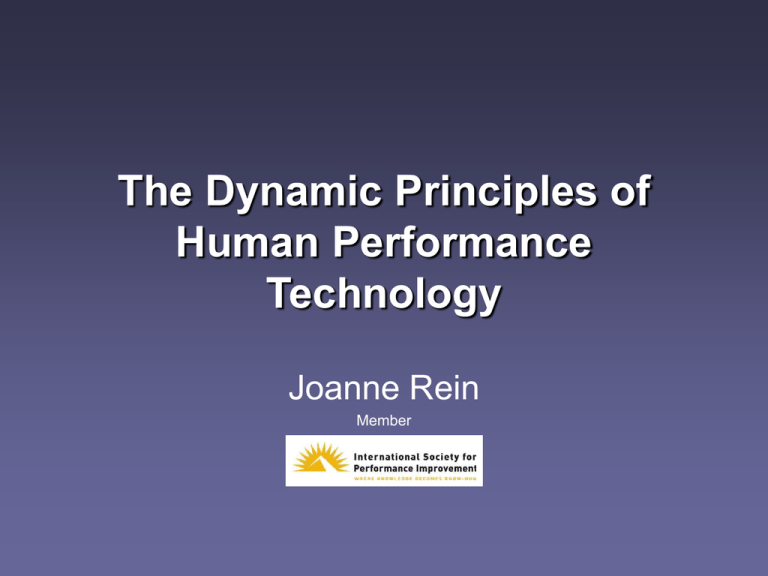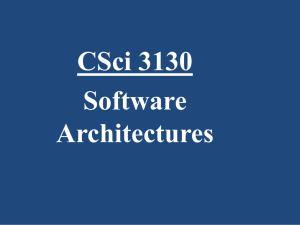HPT - Elance
advertisement

The Dynamic Principles of Human Performance Technology Joanne Rein Member Key Principles of HPT • What are the key principles of human performance technology (HPT)? HPT ? ? ? ? Key Principles of HPT • What are the key principles of human performance technology (HPT)? HPT Focus on Results ? ? ? Key Principles of HPT • What are the key principles of human performance technology (HPT)? HPT Focus On Results Take Systems Viewpoint ? ? Key Principles of HPT • What are the key principles of human performance technology (HPT)? HPT Focus on Results Take Systems Viewpoint Add Value ? Key Principles of HPT • What are the key principles of human performance technology (HPT)? HPT Focus on Results Take Systems Viewpoint Add Value Establish Partnerships Key Principles of HPT • Focus on results – Customize intervention • Take systems viewpoint – Consider all aspects • Add value – Make a difference • Establish partnerships – Communicate Key Principles of HPT • Focus on results – Customize intervention • Take systems viewpoint – Consider all aspects • Add value – Make a difference • Establish partnerships – Communicate Key Principles of HPT • Focus on results – Customize intervention • Take systems viewpoint – Consider all aspects • Add value – Make a difference • Establish partnerships – Communicate Key Principles of HPT • Focus on results – Customize intervention • Take systems viewpoint – Consider all aspects • Add value – Make a difference • Establish partnerships – Communicate HPT Dynamics • Systematic process – Nonlinear – Diverse • Systems approach – Organizational setting – Individual requirements HPT Dynamics • Systematic process – Nonlinear – Diverse • Systems approach – Organizational setting – Individual requirements HPT Dynamics • Dynamic principles – Sytematic process – Systems approach • • • • Focus on results Take systems viewpoint Add value Establish partnership HPT Dynamics • Dynamic principles – Sytematic process – Systems approach • • • • Focus on results Take systems viewpoint Add value Establish partnerships HPT Dynamics • Dynamic principles – Sytematic process – Systems approach • • • • Focus on results Take systems viewpoint Add value Establish partnerships HPT Dynamics • Dynamic principles – Sytematic process – Systems approach • • • • Focus on results Take systems viewpoint Add value Establish partnerships HPT Dynamics • Dynamic principles – Sytematic process – Systems approach • • • • Focus on results Take systems viewpoint Add value Establish partnerships Key Principles of HPT • • • • Focus on results Take systems viewpoint Add value Establish partnerships Results-driven • How do HPT professionals focus on results? Results ? ? Results-driven • How do HPT professionals focus on results? Results – Link HPT to business • Needs • Goals Needs ? Results-driven • How do HPT professionals focus on results? Results – Link HPT to business • Needs • Goals Needs Goals Results-driven • More than one viewpoint – All-inclusive • Forward-looking • Individualized application of principles Results-driven • More than one viewpoint – All-inclusive • Forward-looking • Individualized application of principles Results-driven • More than one viewpoint 1 – All-inclusive • Forward-looking • Individualized application of principles 3 2 Key Principles of HPT • • • • Focus on results Take systems viewpoint Add value Establish partnerships Systems Viewpoint • What does a systems viewpoint take into consideration? System ? ? ? Systems Viewpoint • What does a systems viewpoint take into consideration? System – Worker – Process – Organization Worker ? ? Systems Viewpoint • What does a systems viewpoint take into consideration? System – Worker – Process – Organization Worker Process ? Systems Viewpoint • What does a systems viewpoint take into consideration? System – Worker – Process – Organization Worker Process Organization Key Principles of HPT • • • • Focus on results Take systems viewpoint Add value Establish partnerships Value-added Solutions • What is a valueadded solution? Before HPT Solution Value-added Solutions • What is a valueadded solution? – Add value to the organization • Make a difference Before HPT Solution After HPT Solution Value-added Solutions • What is a valueadded solution? – Add value to the organization • Make a difference Before HPT Solution After HPT Solution Value-added Solutions • Customized assessment of human performance • Not pre-packaged business productivity solutions Key Principles of HPT • • • • Focus on results Take systems viewpoint Add value Establish partnerships Partnerships • What partnerships are effective in HPT? Partnerships ? ? Partnerships • What partnerships are effective in HPT? Partnerships – Clients – Other HPI professionals Clients ? Partnerships • What partnerships are effective in HPT? Partnerships – Clients – Other HPI professionals Clients Other HPI Professionals Partnerships • Share – Creativity – Knowledge – Skills – Successes Creativity Knowledge Successes Skills Partnerships • Share – Creativity – Knowledge – Skills – Successes Creativity Knowledge Successes Skills Partnerships • Share – Creativity – Knowledge – Skills – Successes Creativity Knowledge Successes Skills Partnerships • Share – Creativity – Knowledge – Skills – Successes Creativity Knowledge Successes Skills Partnerships • Share – Creativity – Knowledge – Skills – Successes Creativity Knowledge Successes Skills HPT Dynamics • How is HPT a systematic process? • How is HPT a systems approach? HPT Dynamics Systematic Process HPT Body of Knowledge Grounded Theory Tiered hierarchically Tiered hierarchically Accessed as needed Accessed as needed Searched systematically Applied systematically HPT Dynamics Systematic Process HPT Body of Knowledge Grounded Theory Tiered hierarchically Tiered hierarchically Accessed as needed Accessed as needed Searched systematically Applied systematically HPT Dynamics • Tiered hierarchically Canon Canon Peer-reviewed Peer-reviewed Everything Else HPT Body of Knowledge Grounded Theory HPT Dynamics Systematic Process HPT Body of Knowledge Grounded Theory Tiered hierarchically Tiered hierarchically Accessed as needed Accessed as needed Searched systematically Applied systematically HPT Dynamics • Accessed as needed Canon Peerreviewed Everything Else HPT Body of Knowledge Peer-reviewed Canon Grounded Theory HPT Dynamics Systematic Process HPT Body of Knowledge Grounded Theory Tiered hierarchically Tiered hierarchically Accessed as needed Accessed as needed Searched systematically Applied systematically HPT Dynamics • HPT body of knowledge Canon – Searched systematically Everything Else Peerreviewed • Grounded theory – Applied systematically Canon Peerreviewed HPT Dynamics • How is HPT a systematic process? • How is HPT a systems approach? HPT Dynamics • Take systems viewpoint ? – Provide comprehensive analysis Comprehensive Analysis ? ? HPT Dynamics • Take systems viewpoint Organization – Provide comprehensive analysis • Organization • Process • Worker Comprehensive Analysis ? ? HPT Dynamics • Take systems viewpoint Organization – Provide comprehensive analysis • Organization • Process • Worker Comprehensive Analysis ? Process HPT Dynamics • Take systems viewpoint Organization – Provide comprehensive analysis • Organization • Process • Worker Comprehensive Analysis Worker Process HPT Dynamics • Systematic process • Systems approach HPT Dynamics • Systematic process • Systems approach HPT Dynamics • HPT mindset – Systematic process • Micro analysis – Systems approach • Macro analysis The Nine Performance Variables The 3 Performance Needs The 3 Levels of Performance Goals Design Management Organization Level Organization Goals Organization Design Organization Management Process Level Process Goals Process Design Process Management Job/Performer Level Job Goals Job Design Job Management Table 1. The Nine Performance Variables. Rummler, G. A. & Brache, A. P. (1995). Improving performance; How to manage the white space on the organization chart (2 nd ed.) San Francisco: Jossey-Bass. The Nine Performance Variables The 3 Performance Needs The 3 Levels of Performance Goals Design Management Organization Level Organization Goals Organization Design Organization Management Process Level Process Goals Process Design Process Management Job/Performer Level Job Goals Job Design Job Management Table 1. The Nine Performance Variables. Rummler, G. A. & Brache, A. P. (1995). Improving performance; How to manage the white space on the organization chart (2 nd ed.) San Francisco: Jossey-Bass. The Nine Performance Variables The 3 Performance Needs The 3 Levels of Performance Goals Design Management Organization Level Organization Goals Organization Design Organization Management Process Level Process Goals Process Design Process Management Job/Performer Level Job Goals Job Design Job Management Table 1. The Nine Performance Variables. Rummler, G. A. & Brache, A. P. (1995). Improving performance; How to manage the white space on the organization chart (2 nd ed.) San Francisco: Jossey-Bass. The Nine Boxes Model Goals Organization Process Performer Design Management Strategy, Operating Plans, & Metrics Organization Structure & Overall Business Model Performance Review Practices & Management Culture Customer & Business Requirements Process Design, Systems Design, & Workspace Design Process Ownership, Process Management, & Continuous Improvement Job Specifications, Performance Metrics, & Individual Development Plans Job Roles And Responsibilities, Skill Requirements, Procedures, Tools, & Training Performance Feedback, Consequences, Coaching, & Support Table 2. The Nine Boxes Model. Rummler-Brache Group (n.d.). Improving business processes, strategies and capabilities. Retrieved November 26, 2008, from http://www.rummler-brache.com/the-nine-boxes-model The Nine Boxes Model Goals Organization Process Performer Design Management Strategy, Operating Plans, & Metrics Organization Structure & Overall Business Model Performance Review Practices & Management Culture Customer & Business Requirements Process Design, Systems Design, & Workspace Design Process Ownership, Process Management, & Continuous Improvement Job Specifications, Performance Metrics, & Individual Development Plans Job Roles And Responsibilities, Skill Requirements, Procedures, Tools, & Training Performance Feedback, Consequences, Coaching, & Support Table 2. The Nine Boxes Model. Rummler-Brache Group (n.d.). Improving business processes, strategies and capabilities. Retrieved November 26, 2008, from http://www.rummler-brache.com/the-nine-boxes-model The Nine Boxes Model Goals Organization Process Performer Design Management Strategy, Operating Plans, & Metrics Organization Structure & Overall Business Model Performance Review Practices & Management Culture Customer & Business Requirements Process Design, Systems Design, & Workspace Design Process Ownership, Process Management, & Continuous Improvement Job Specifications, Performance Metrics, & Individual Development Plans Job Roles And Responsibilities, Skill Requirements, Procedures, Tools, & Training Performance Feedback, Consequences, Coaching, & Support Table 2. The Nine Boxes Model. Rummler-Brache Group (n.d.). Improving business processes, strategies and capabilities. Retrieved November 26, 2008, from http://www.rummler-brache.com/the-nine-boxes-model The 4 Levels of Performance Level Work Environment Workplace Work Process Worker Performance Unit of Analysis (System) Intervention Tools (Design & Technology) Business Performance • Business Performance System (Condition, Input, Process, Output, Feedback, & Consequence) • System Variables: Brand Value, Product Or Service Positioning, Market Strategy, Vision & Mission, & So On • Business Design: Vision Design, Innovation Design, Mergers, & Acquisitions • Business Technology: Market Opportunity Analysis, Future Research & Simulation, & Positioning & Promotion Strategy Organization Performance • Organization Performance System (Condition, Input, Process, Output, Feedback, & Consequence) • System Variables: Organizational Structure, Culture, & Ergonomics • Organization Design: Culture Change, Workplace Design, & Restructuring • Organizational Technology: Organizational Development, Financial Management, & Communities of Practice Process Performance • Process Performance System (Condition, Input, Process, Output, Feedback, & Consequence) • System Variables: Communication, Supply Chain, & Production • Process Design: Electronic Performance Support Systems, Reengineering, & Outsourcing • Process Technology: Process Mapping, Knowledge Management, & Financial Accounting Human Performance • Human Performance System (Condition, Input, Process, Output, Feedback, & Consequence) • System Variables: Skills, Knowledge, Competency, Motivation, & Leadership • Leadership Design: Mental Model, Capacity Building, & Incentive System • Leadership Technology: Training, Job Aid, Performance Appraisal, Leadership Development, Career Consulting, & Mentoring Table 3. The Four Levels of Performance Framework. Jang, H. Y. (2008). Reconsidering human performance technology [Electronic version]. Performance improvement, 47(6), 29. DOI: 10.1002/pfi.20006. The 4 Levels of Performance Level Work Environment Workplace Work Process Worker Performance Unit of Analysis (System) Intervention Tools (Design & Technology) Business Performance • Business Performance System (Condition, Input, Process, Output, Feedback, & Consequence) • System Variables: Brand Value, Product Or Service Positioning, Market Strategy, Vision & Mission, & So On • Business Design: Vision Design, Innovation Design, Mergers, & Acquisitions • Business Technology: Market Opportunity Analysis, Future Research & Simulation, & Positioning & Promotion Strategy Organization Performance • Organization Performance System (Condition, Input, Process, Output, Feedback, & Consequence) • System Variables: Organizational Structure, Culture, & Ergonomics • Organization Design: Culture Change, Workplace Design, & Restructuring • Organizational Technology: Organizational Development, Financial Management, & Communities of Practice Process Performance • Process Performance System (Condition, Input, Process, Output, Feedback, & Consequence) • System Variables: Communication, Supply Chain, & Production • Process Design: Electronic Performance Support Systems, Reengineering, & Outsourcing • Process Technology: Process Mapping, Knowledge Management, & Financial Accounting Human Performance • Human Performance System (Condition, Input, Process, Output, Feedback, & Consequence) • System Variables: Skills, Knowledge, Competency, Motivation, & Leadership • Leadership Design: Mental Model, Capacity Building, & Incentive System • Leadership Technology: Training, Job Aid, Performance Appraisal, Leadership Development, Career Consulting, & Mentoring Table 3. The Four Levels of Performance Framework. Jang, H. Y. (2008). Reconsidering human performance technology [Electronic version]. Performance improvement, 47(6), 29. DOI: 10.1002/pfi.20006. The 4 Levels of Performance Level Work Environment Workplace Work Process Worker Performance Unit of Analysis (System) Intervention Tools (Design & Technology) Business Performance • Business Performance System (Condition, Input, Process, Output, Feedback, & Consequence) • System Variables: Brand Value, Product Or Service Positioning, Market Strategy, Vision & Mission, & So On • Business Design: Vision Design, Innovation Design, Mergers, & Acquisitions • Business Technology: Market Opportunity Analysis, Future Research & Simulation, & Positioning & Promotion Strategy Organization Performance • Organization Performance System (Condition, Input, Process, Output, Feedback, & Consequence) • System Variables: Organizational Structure, Culture, & Ergonomics • Organization Design: Culture Change, Workplace Design, & Restructuring • Organizational Technology: Organizational Development, Financial Management, & Communities of Practice Process Performance • Process Performance System (Condition, Input, Process, Output, Feedback, & Consequence) • System Variables: Communication, Supply Chain, & Production • Process Design: Electronic Performance Support Systems, Reengineering, & Outsourcing • Process Technology: Process Mapping, Knowledge Management, & Financial Accounting Human Performance • Human Performance System (Condition, Input, Process, Output, Feedback, & Consequence) • System Variables: Skills, Knowledge, Competency, Motivation, & Leadership • Leadership Design: Mental Model, Capacity Building, & Incentive System • Leadership Technology: Training, Job Aid, Performance Appraisal, Leadership Development, Career Consulting, & Mentoring Table 3. The Four Levels of Performance Framework. Jang, H. Y. (2008). Reconsidering human performance technology [Electronic version]. Performance improvement, 47(6), 29. DOI: 10.1002/pfi.20006. The 4 Levels of Performance Level Work Environment Workplace Work Process Worker Performance Unit of Analysis (System) Intervention Tools (Design & Technology) Business Performance • Business Performance System (Condition, Input, Process, Output, Feedback, & Consequence) • System Variables: Brand Value, Product Or Service Positioning, Market Strategy, Vision & Mission, & So On • Business Design: Vision Design, Innovation Design, Mergers, & Acquisitions • Business Technology: Market Opportunity Analysis, Future Research & Simulation, & Positioning & Promotion Strategy Organization Performance • Organization Performance System (Condition, Input, Process, Output, Feedback, & Consequence) • System Variables: Organizational Structure, Culture, & Ergonomics • Organization Design: Culture Change, Workplace Design, & Restructuring • Organizational Technology: Organizational Development, Financial Management, & Communities of Practice Process Performance • Process Performance System (Condition, Input, Process, Output, Feedback, & Consequence) • System Variables: Communication, Supply Chain, & Production • Process Design: Electronic Performance Support Systems, Reengineering, & Outsourcing • Process Technology: Process Mapping, Knowledge Management, & Financial Accounting Human Performance • Human Performance System (Condition, Input, Process, Output, Feedback, & Consequence) • System Variables: Skills, Knowledge, Competency, Motivation, & Leadership • Leadership Design: Mental Model, Capacity Building, & Incentive System • Leadership Technology: Training, Job Aid, Performance Appraisal, Leadership Development, Career Consulting, & Mentoring Table 3. The Four Levels of Performance Framework. Jang, H. Y. (2008). Reconsidering human performance technology [Electronic version]. Performance improvement, 47(6), 29. DOI: 10.1002/pfi.20006. The Organizational Scan Condition Process Outcomes Strategy, Structure Mission, strategy External business drivers Functional grouping Budget/decision authority Systems Degree of centralization Consistency of operations Flexibility Organizational Results Satisfaction of investors Satisfaction of societal stakeholders Measures of success Goal alignment with mission People Level Climate Practices Company values, individual values Management/leadership practices Team norms Ethics, integrity Performance Requirements Skills, knowledge Job aids/references Selection Conference Motivation, Feedback Satisfaction of employees Frequency, timing, form Rewards and recognition Expectations Work Level Environment, Resources Physical environment Tools, materials, information Support personnel/services Accessibility of resources Workload, demands Methods Allocation of functions Processes, procedures Work flow Duplication/gaps Products, Services Satisfaction of customers Productivity levels Standards/criteria Quality of product delivery Organization Level Table 4. Organizational Scan. Tosti, D., & Jackson, S. D. (1997). The organizational scan. Performance Improvement, 36(10), 22-26. The Organizational Scan Condition Process Outcomes Strategy, Structure Mission, strategy External business drivers Functional grouping Budget/decision authority Systems Degree of centralization Consistency of operations Flexibility Organizational Results Satisfaction of investors Satisfaction of societal stakeholders Measures of success Goal alignment with mission People Level Climate Practices Company values, individual values Management/leadership practices Team norms Ethics, integrity Performance Requirements Skills, knowledge Job aids/references Selection Conference Motivation, Feedback Satisfaction of employees Frequency, timing, form Rewards and recognition Expectations Work Level Environment, Resources Physical environment Tools, materials, information Support personnel/services Accessibility of resources Workload, demands Methods Allocation of functions Processes, procedures Work flow Duplication/gaps Products, Services Satisfaction of customers Productivity levels Standards/criteria Quality of product delivery Organization Level Table 4. Organizational Scan. Tosti, D., & Jackson, S. D. (1997). The organizational scan. Performance Improvement, 36(10), 22-26. The Organizational Scan Condition Process Outcomes Strategy, Structure Mission, strategy External business drivers Functional grouping Budget/decision authority Systems Degree of centralization Consistency of operations Flexibility Organizational Results Satisfaction of investors Satisfaction of societal stakeholders Measures of success Goal alignment with mission People Level Climate Practices Company values, individual values Management/leadership practices Team norms Ethics, integrity Performance Requirements Skills, knowledge Job aids/references Selection Conference Motivation, Feedback Satisfaction of employees Frequency, timing, form Rewards and recognition Expectations Work Level Environment, Resources Physical environment Tools, materials, information Support personnel/services Accessibility of resources Workload, demands Methods Allocation of functions Processes, procedures Work flow Duplication/gaps Products, Services Satisfaction of customers Productivity levels Standards/criteria Quality of product delivery Organization Level Table 4. Organizational Scan. Tosti, D., & Jackson, S. D. (1997). The organizational scan. Performance Improvement, 36(10), 22-26. Summary “One sign of a vibrant and healthy discipline is the ability to tap into new developments, innovate, and also capture insights from other fields. . .The last decade has seen a tremendous expansion in the number of performance consultants as well as new ways in which the performance field has evolved” Joe Willmore Summary • Key principles of HPT – Focus on results – Take systems viewpoint – Add value – Establish partnerships Focus on Results Take Systems Viewpoint Establish Partnerships Add Value • HPT dynamics – Systematic process – Systems approach Summary • Key principles of HPT – Focus on results – Take systems viewpoint – Add value – Establish partnerships Focus on Results Take Systems Viewpoint Establish Partnerships Add Value • HPT dynamics – Systematic process – Systems approach Summary • Key principles of HPT – Focus on results – Take systems viewpoint – Add value – Establish partnerships Focus on Results Take Systems Viewpoint Establish Partnerships Add Value • HPT dynamics – Systematic process – Systems approach Summary • Key principles of HPT – Focus on results – Take systems viewpoint – Add value – Establish partnerships Focus on Results Take Systems Viewpoint Establish Partnerships Add Value • HPT dynamics – Systematic process – Systems approach Summary • Key principles of HPT – Focus on results – Take systems viewpoint – Add value – Establish partnerships Focus on Results Take Systems Viewpoint Establish Partnerships Add Value • HPT dynamics – Systematic process – Systems approach Summary • Key principles of HPT – Focus on results – Take systems viewpoint – Add value – Establish partnerships Focus on Results Take Systems Viewpoint Establish Partnerships Add Value • HPT dynamics – Systematic process – Systems approach Summary • Key principles of HPT – Focus on results – Take systems viewpoint – Add value – Establish partnerships Focus on Results Take Systems Viewpoint Establish Partnerships Add Value • HPT dynamics – Systematic process – Systems approach Summary • Key principles of HPT – Focus on results – Take systems viewpoint – Add value – Establish partnerships Focus on Results Take Systems Viewpoint Establish Partnerships Add Value • HPT dynamics – Systematic process – Systems approach References Addison, R. M., & Haig, C. (2006). The performance architect’s essential guide to the performance technology landscape. In J. A. Pershing (Ed.). Handbook of human performance technology: Principles, practices, and potential (3rd ed.). San Francisco: Pfeiffer. Jang, H. Y. (2008). Reconsidering human performance technology [Electronic version]. Performance improvement, 47(6), 26. DOI: 10.1002/pfi.20006. References Rummler, G. A., & Brache, A. P. (1995). Improving performance; How to manage the white space on the organization chart (2nd ed.) San Francisco: Jossey-Bass. Rummler-Brache Group (n.d.). Improving business processes, strategies and capabilities. Retrieved November 26, 2008, from http://www.rummlerbrache.com/the-nine-boxes-model References Tosti, D., & Jackson, S. D. (1997). The organizational scan. Performance Improvement, 36(10), 22-26. Willmore, J. (2008). The evolution of human performance improvement. In Biech (Ed.), Handbook for Workplace Learning Professionals (pp. 33-46). ASTD Press. Questions?







